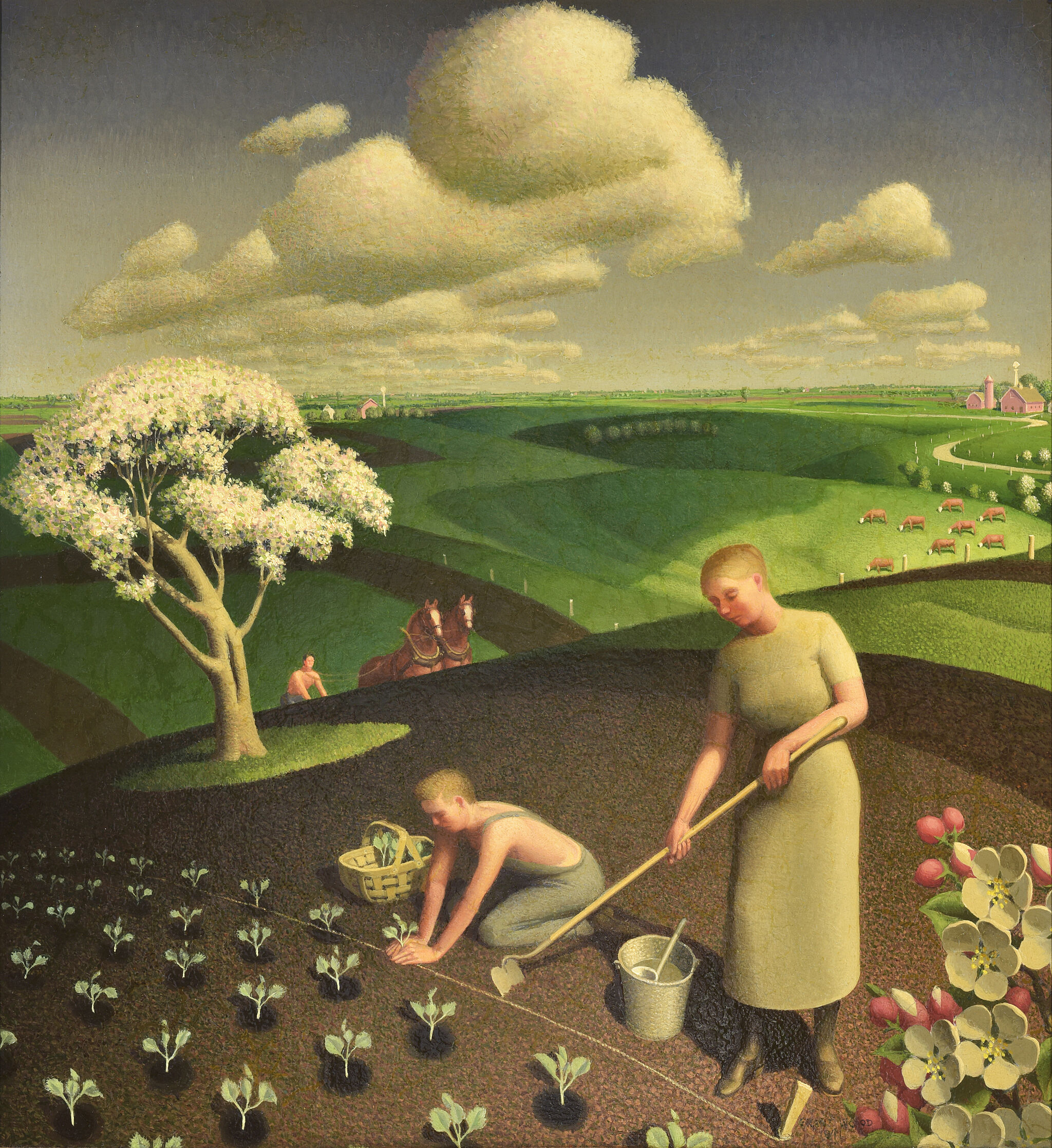



Spring in Town (1941) and Anamosa (circa 1900).
Grant DeVolson Wood was born on a farm located four miles east of Anamosa, Iowa on February 13, 1891, the son of Francis M. Wood and Hattie (Weaver) Wood. When Grant was ten years old, his father died, and Hattie moved with her four children to Cedar Rapids. While attending school, Wood worked at odd jobs, including apprenticing in a local metal shop, to help support his family. On occasion, Grant entered art competitions, and in 1905, his drawing of oak leaves took third place in a national contest sponsored by Crayola.


Grant Wood’s boyhood home in Cedar Rapids (across from Coe College) – listed as one of the most endangered historic sites in Iowa.
Grant entered Washington High School in 1906 and met Marvin Cone, a classmate also interested in art. The two became lifelong friends and, while in high school, worked together on a variety of projects, including designing theater seats for the Cedar Rapids Art Association. Grant also provided artwork for the school’s yearbook and literary magazine, graduating in 1910.
Wood’s formal training in art was limited but included two summers in Minneapolis studying at the school of Design, Handicraft, and Normal Art; a life-drawing class taught by Charles A. Cumming at the University of Iowa; and occasional classes at the Art Institute of Chicago. In 1916, financial troubles hit the Wood family, so Grant stepped up, building a new house for his mother, sister Nan, and himself, after the family lost their first home.


(Above left) Grant Wood when he joined the military during WW I (1917-1918).
During WW I (1917-1918) Grant served stateside in the U.S. Army as a camouflage artist, and, upon his return home to Cedar Rapids (1919), he pursued painting while supporting himself as an art teacher (Jackson and McKinley Schools), metalworker, and interior designer.


FYI: Jackson School was located on Fourth Avenue SE, which is not too far from Mercy Hospital and McKinley. It was razed in the 1960’s, but, before its demise, not only did it have Grant Wood as a teacher, but it also could claim the Wright Brothers (1878-1881) and Mamie Eisenhower (1896-1902) as students!

Grant’s early artistic style was influenced by French Impressionism and from 1923 to 1924 he studied at the Academie Julian in Paris, where he studied, painted, and exhibited. Upon his return to Iowa, Wood was “commissioned” to complete several projects including The Stained Glass Window at the Veterans Memorial Building in Cedar Rapids (below), plus large murals for the Eppley Hotels in Cedar Rapids, Sioux City, Waterloo, and Council Bluffs.


Grant Wood’s Stained Glass window in Veteran’s Memorial Building was completed in 1928. Standing sixteen-feet tall is a central, super-human figure which is said to represent the “Republic.” Draped over her head is a blue mourning veil, her body surrounded by clouds. In her right hand, she holds the palm branch of peace; in her left, the laurel wreath of victory. Solemnly standing at the base are six soldiers donning the uniform of Private, representing the wars (from left to right): Revolutionary War, The War of 1812, The Mexican War, Civil War, Spanish-American War and the First World War.






In 1924, as Grant was doing some interior decorating for David Turner of Turner Mortuary, Turner offered a carriage house behind the mortuary as a studio for Wood. The now legendary 5 Turner Alley, as Grant called it, became both a home to Wood and his mother, as well as his studio during the most productive period of his career (1924-1935).


In August 1930, Grant was driving around the little southeastern town of Eldon, Iowa with a young local painter named John Sharp. Looking for inspiration, he noticed the Dibble House, a small white home built in the Carpenter Gothic architectural style. After obtaining permission from the owners, Wood made a sketch the next day from the front yard.

Upon his return to Cedar Rapids, Grant decided to paint the house along with, in his words, “the kind of people [I] fancied should live in that house.” He recruited his sister, Nan, to be the model for the daughter, dressing her in a colonial print apron mimicking early 20th-century rural Americana. The model for the father was the Wood family’s dentist, Dr. Byron McKeeby from Cedar Rapids.


Wood entered the painting in a competition at the Art Institute of Chicago. One judge deemed it a “comic valentine,” but a museum patron persuaded the jury to award the painting a bronze medal and a $300 cash prize. That same patron also persuaded the Institute to buy the painting, and it remains part of the Chicago museum’s collection today. The image soon began appearing in newspapers, first by the Chicago Evening Post, and then in New York, Boston, Kansas City, and Indianapolis.

When the image finally appeared in The Cedar Rapids Gazette, there was a big backlash. Iowans were furious at their depiction as “pinched, grim-faced, puritanical Bible-thumpers.” Wood protested, saying that he had not painted a caricature of Iowans but a depiction of his appreciation, stating…


Interestingly enough, with the deepening of the Great Depression (1930’s), American Gothic came to be seen, not as a negative, but as a beautiful depiction of the steadfast American pioneer spirit needed to survive the hardships of life. Wood assisted this interpretive transition by grouping himself with populist Midwestern painters such as John Steuart Curry and Thomas Hart Benton, who revolted against the dominance of East Coast art circles.

Wood, who loved portraying himself as the artist in overalls, was quoted as stating…

With the phenomenal success of American Gothic, doors opened wide for Grant, with many wanting to learn more about his art style and technique. In response to this popularity, in the mid-1930’s, Wood, along with his friend Marvin Cone, established a small art community in eastern Iowa, the Stone City Colony and Art School. Here, art students and nationally prominent teachers, including Wood, Thomas Hart Benton and John Steuart Curry, stayed in abandoned limestone buildings and camped in obsolete horse-drawn ice wagons loaned by Hubbard Ice Co. of Cedar Rapids. Participants painted by day, partied by night and sold their work to crowds of visitors on weekends. The project was a financial bust but attracted national attention in the summers of 1932 and ’33.




In 1934, Grant was offered the position of director of the Public Works of Art Program (PWAP), a work relief program in Iowa City, developed by Roosevelt’s Works Progress Administration (WPA). In this role, Grant assisted many other artists and art students in producing murals for state institutions such as post offices, and colleges. It’s here, Grant Wood became a mentor to Mildred Pelzer, creator of eight Iowa City-themed murals used in the Jefferson Hotel. Click here to read more about that story.


Iowa’s Corn Field (1941) and January (1940-41)
Once Grant’s PWAP work concluded, the University of Iowa offered him a full-time position as Associate Professor of Fine Art, which he kept until his premature death in 1942.



Grant moved to Iowa City in 1935 after having commuted from his 5 Turner Alley Studio for a year. This move coincided with his four-year marriage to Sara Sherman Maxon, a fellow Iowa artist, who found success on Broadway before becoming the first director of Michigan City’s School of Fine Arts in the mid-1920’s (see pics above). Apparently, the couple met in Cedar Rapids, married in Minneapolis (1935), and tried making a home together in Iowa City until their divorce in September 1939.


When Grant and Sara moved to Iowa City, they bought a home built in 1858 by the brick manufacturer, Nicholas Oakes, located at 1142 East Court Street. During their married years (1935-1939), Grant made extensive renovations to 1142, as he called it, designing his own furniture, restoring historic features, and changing the landscaping.


Grant’s mother, Haddie, moved in to 1142 with the couple for just a short time before her death in 1935.



Wood created many lithographs while at the house, including those for the Associated American Artists. He featured 1142 in Parson Weems’ Fable (1939), considering his restoration of the home as his finest artistic achievement. In 1978, 1142 (Oakes-Wood House) was placed in the National Register of Historic Places.


On February 12, 1942, one day before his 51st birthday, Grant Wood died at SUI Hospital as he was suffering from pancreatic cancer. Wood is buried at Riverside Cemetery, Anamosa, Iowa, alongside Nan, his sister, and his beloved mother, Hattie.




Grant Wood’s artwork has appeared on both a US stamp and coin. In 1996, Grant’s “Young Corn” (1931) appeared on the Iowa State Sesquicentennial USPS stamp (above). A design based on Wood’s “Arbor Day” (1932) was chosen by the US Mint for the Iowa state quarter, issued in 2004 (below).


(C-0180) U.S. Mint: Iowa State Quarter – Issued: August 30, 2004 City: Anamosa, Iowa. This is the 29th coin released in the 50 State Quarters Program and the fourth released in 2004. Iowa themed the coin Foundation in Education. It highlights a one-room schoolhouse with a teacher and students planting a tree, and the inscriptions Foundation in Education and Grant Wood.




In 2009, Grant Wood was awarded The Iowa Award, the highest honor given to an Iowan. Read more here.



Step into a Grant Wood painting as you traverse this scenic byway that stretches 80 miles from Stone City to the Mississippi River. The Grant Wood Scenic Byway passes through both the hometown of this iconic American artist and beautiful settings that inspired him. Click here for more information…


Several years back, when visiting Sandy’s mom in Goshen, Indiana, American Gothic was part of this fantastic traveling art show. You just never know when Grant Wood’s iconic piece will pop up wherever you travel!


Iowa’s Artist – gone too soon. Godspeed – Grant Wood – Godspeed!

DYK-December 21, 2022
DYK-July 19, 2023

Kudos to the amazing resources below for the many quotes, photographs, etc. used on this page.

Artist-Grant Wood Art Collection, Cedar Rapids Community Schools
Stone City (painting), Grant Wood, Wikipedia, 1930
Memorial Stained Glass Window, Veteran’s Memorial Building, Cedar Rapids, 1928
The Early Days of Kanesville, Grant Wood, 1926-27, Cedar Rapids Community Schools
Jackson School History, Cedar Rapids, Cedar Rapids Community Schools
Saturday Postcard 224: Grant Wood – an Iowa City institution, Bob Hibbs, IAGenWeb, December 20, 2003
American Gothic (painting), Grant Wood, Wikipedia
Rural Midwest: Paintings of Grant Wood, Hoakley, The Eclectic Light Company, March 20, 2020
Sara Sherman Maxon Rediscovered, The Beacher Weekly Newspaper, September 18, 2014
Grant Wood Scenic Byway, Travel Iowa
Click here to go on to the next section…
Click here for a complete INDEX of Our Iowa Heritage stories…


